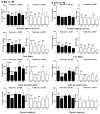Longitudinal changes and tracking of in-school physical activity in primary school children: four-year longitudinal study
- PMID: 40102823
- PMCID: PMC11917022
- DOI: 10.1186/s12889-025-22256-8
Longitudinal changes and tracking of in-school physical activity in primary school children: four-year longitudinal study
Abstract
Background: There is little evidence on the tracking of physical activity during school hours. In addition, tracking physical activity in schools provides important evidence for understanding children's physical activity and conducting intervention studies. Therefore, this study examined longitudinal changes and tracking of in-school physical activity in primary school children.
Methods: In this study, physical activity was investigated longitudinally in primary school children for 4 years. The baseline participants consisted of 103 second-grade students (7-8 years old) who participated. Step counts and moderate-to-vigorous physical activity (MVPA) in school and during first recess and lunch/second recess were examined using an accelerometer (Kenz Lifecorder GS 4-second version; Suzuken Co. Ltd, Nagoya, Japan).
Results: After excluding missing data (moving school; n = 8, physical activity; n = 8), 87 (43 boys and 44 girls) of whom were included in the final analysis. Step counts and MVPA during school and physical education in boys did not decrease across the school years. By contrast, in girls, step counts during school did not decrease across the school years, however MVPA did decrease. In addition, for both sexes, step counts and MVPA during first recess decrease across the school years. During lunch/second recess, only step counts decrease across the school years in both sexes. In addition, the tracking coefficients for step counts and MVPA for boys in school and during first recess and lunch/second recess were found across many school years. Contrarily, girls had fewer significant tracking coefficients between school years than boys. There were also few significant tracking coefficients between grades for physical education step counts and MVPA for both boys and girls.
Conclusions: Our results suggested that in-school step counts for both boys and girls does not decrease across the school years. However, given that girls demonstrated reduced levels of in-school MVPA across the school years, it is important to promote strategies to increase MVPA in this group.
Keywords: Longitudinal study; Moderate-to-vigorous physical activity; Physical activity; Physical education; Recess; Step counts; Tracking; Youth.
© 2025. The Author(s).
Conflict of interest statement
Declarations. Ethics approval and consent to participate: This study was approved by the Institutional Review Board of the Okayama University (approval No. H3001) and was conducted according to the principles of the Declaration of Helsinki. Written informed consent was obtained from all the participants and all parents of the participating children before their involvement in the study. Consent for publication: Not applicable. Competing interests: The authors declare no competing interests.
Figures


Similar articles
-
Accelerometer measured physical activity patterns of children during segmented school day in Abu Dhabi.BMC Pediatr. 2021 Apr 17;21(1):182. doi: 10.1186/s12887-021-02639-7. BMC Pediatr. 2021. PMID: 33865344 Free PMC article.
-
The challenge of low physical activity during the school day: at recess, lunch and in physical education.Br J Sports Med. 2011 Aug;45(10):813-9. doi: 10.1136/bjsm.2009.068072. Epub 2010 Mar 9. Br J Sports Med. 2011. PMID: 20215489 Clinical Trial.
-
Changes in compliance with school-based physical activity recommendations in Spanish youth: The UP&DOWN longitudinal study.Scand J Med Sci Sports. 2019 Apr;29(4):554-565. doi: 10.1111/sms.13355. Epub 2019 Jan 7. Scand J Med Sci Sports. 2019. PMID: 30548572
-
Evidence-Based Overview of Accelerometer-Measured Physical Activity during School Recess: An Updated Systematic Review.Int J Environ Res Public Health. 2021 Jan 12;18(2):578. doi: 10.3390/ijerph18020578. Int J Environ Res Public Health. 2021. PMID: 33445554 Free PMC article.
-
Longitudinal changes in moderate-to-vigorous-intensity physical activity in children and adolescents: A systematic review and meta-analysis.Obes Rev. 2020 Jan;21(1):e12953. doi: 10.1111/obr.12953. Epub 2019 Oct 23. Obes Rev. 2020. PMID: 31646739 Free PMC article.
References
-
- Poitras VJ, Gray CE, Borghese MM, Carson V, Chaput JP, Janssen I, et al. Systematic review of the relationships between objectively measured physical activity and health indicators in school-aged children and youth. Appl Physiol Nutr Metab. 2016;41(suppl 3):S197–239. 10.1139/apnm-2015-0663 - PubMed
-
- Strong WB, Malina RM, Blimkie CJR, Daniels SR, Dishman RK, Gutin B, et al. Evidence based physical activity for school-age youth. J Pediatr. 2005;146:732–7. 10.1016/j.jpeds.2005.01.055 - PubMed
MeSH terms
Grants and funding
LinkOut - more resources
Full Text Sources
Medical

